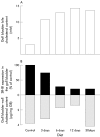Expression and regulation of scavenger receptor class B type I (SR-BI) in gall bladder epithelium
- PMID: 12801960
- PMCID: PMC1773711
- DOI: 10.1136/gut.52.7.1017
Expression and regulation of scavenger receptor class B type I (SR-BI) in gall bladder epithelium
Abstract
Background and aims: Biliary lipid absorption by the gall bladder mucosa and the cholesterol content of the gall bladder wall appear to play a role in cholesterol gall stone formation. As the scavenger receptor class B type I (SR- BI) regulates cellular cholesterol uptake, we studied its expression in human and murine gall bladders, its regulation by increased biliary lipid content, and its role in gall stone formation.
Methods and results: Using immunohistochemistry, SR-BI was found in the apical domain of human gall bladder epithelial cells. Immunoblotting of isolated membranes from gall bladder epithelial cells showed a specific signal for the 82 kDa SR-BI protein. In C57BL/6 mice, SR-BI was also found in the gall bladder epithelium. Using western blot analysis, an inverse relationship was observed between biliary cholesterol concentration and SR-BI expression in murine gall bladder mucosa. By comparing lithogenic diet fed wild-type and SR-BI deficient mice, gall bladder wall cholesterol content and gall stone formation were not found to be dependent on SR-BI expression.
Conclusions: (i) SR-BI is expressed in both human and murine gall bladder epithelium; (ii) biliary cholesterol hypersecretion is associated with decreased gall bladder SR-BI expression in mice; and (iii) murine SR-BI is not essential in controlling gall bladder wall cholesterol content and gall stone formation during diet induced cholelithiasis.
Figures






Similar articles
-
Susceptibility to murine cholesterol gallstone formation is not affected by partial disruption of the HDL receptor SR-BI.Biochim Biophys Acta. 2002 Jul 11;1583(2):141-50. doi: 10.1016/s1388-1981(02)00194-4. Biochim Biophys Acta. 2002. PMID: 12117558
-
Expression of scavenger receptor class B type I in gallbladder columnar epithelium.J Gastroenterol Hepatol. 2002 Jun;17(6):713-20. doi: 10.1046/j.1440-1746.2002.02776.x. J Gastroenterol Hepatol. 2002. PMID: 12100619
-
Down-regulation of intestinal scavenger receptor class B, type I (SR-BI) expression in rodents under conditions of deficient bile delivery to the intestine.Biochem J. 2001 Jun 1;356(Pt 2):317-25. doi: 10.1042/0264-6021:3560317. Biochem J. 2001. PMID: 11368757 Free PMC article.
-
The role of the high-density lipoprotein receptor SR-BI in the lipid metabolism of endocrine and other tissues.Endocr Rev. 2003 Jun;24(3):357-87. doi: 10.1210/er.2001-0037. Endocr Rev. 2003. PMID: 12788804 Review.
-
Influence of the HDL receptor SR-BI on lipoprotein metabolism and atherosclerosis.Arterioscler Thromb Vasc Biol. 2003 Oct 1;23(10):1732-8. doi: 10.1161/01.ATV.0000091363.28501.84. Epub 2003 Aug 14. Arterioscler Thromb Vasc Biol. 2003. PMID: 12920050 Review.
Cited by
-
Cholesterol gallstone disease: focusing on the role of gallbladder.Lab Invest. 2015 Feb;95(2):124-31. doi: 10.1038/labinvest.2014.140. Epub 2014 Dec 15. Lab Invest. 2015. PMID: 25502177 Review.
-
Bladder cancer SNP panel predicts susceptibility and survival.Hum Genet. 2009 Jun;125(5-6):527-39. doi: 10.1007/s00439-009-0645-6. Epub 2009 Mar 1. Hum Genet. 2009. PMID: 19252927 Free PMC article.
-
The neglected cousin of the hepatocyte: how gallbladder epithelial cells might contribute to cholesterol gallstone formation.Dig Dis Sci. 2013 Feb;58(2):296-8. doi: 10.1007/s10620-012-2541-5. Epub 2013 Jan 31. Dig Dis Sci. 2013. PMID: 23371007 No abstract available.
-
Effect of nicotine on cholesterol gallstone formation in C57BL/6J mice fed on a lithogenic diet.Exp Ther Med. 2023 Jan 3;25(2):84. doi: 10.3892/etm.2023.11783. eCollection 2023 Feb. Exp Ther Med. 2023. PMID: 36684657 Free PMC article.
-
Single Cell RNA-Sequencing Reveals a Murine Gallbladder Cell Transcriptome Atlas During the Process of Cholesterol Gallstone Formation.Front Cell Dev Biol. 2021 Sep 28;9:714271. doi: 10.3389/fcell.2021.714271. eCollection 2021. Front Cell Dev Biol. 2021. PMID: 34650971 Free PMC article.
References
-
- Apstein MD, Carey MC. Pathogenesis of cholesterol gallstones: a parsimonious hypothesis. Eur J Clin Invest 1996;26:343–52. - PubMed
-
- Shiffman MI, Sugerman HJ, Moore EW. Human gallbladder mucosal function. Gastroenterology 1990; 99:1452–9. - PubMed
-
- Giannini Corradini S, Yamashita G, Nuutinen H, et al. Human gallbladder mucosal function. Effects on intraluminal fluid and lipid composition in health and disease. Dig Dis Sci 1998; 43:335–43. - PubMed
-
- Das JB, Poulos ND, Ansari GG. Biliary lipid composition and bile acid profile during and after enteral fast of total parenteral nutrition in the rabbit. J Pediatric Gastroenterol Nutr 1996; 22:85–91. - PubMed
-
- Ostrow JD. Absorption by the gallbladder of bile salts, sulfobromophtalein, and iodipamide. J Lab Clin Med 1969;74:482–94. - PubMed
Publication types
MeSH terms
Substances
LinkOut - more resources
Full Text Sources
Other Literature Sources
Medical
Research Materials
